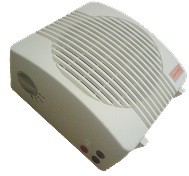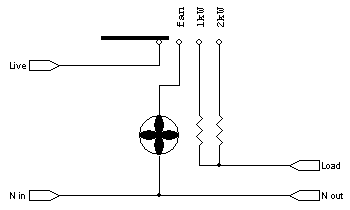|
There are many times one wants to power a circuit to full potential, but should a fault occur then have the maximum current limited so as to contain the energy. An example of such a time is when testing power factor correction capacitors for internal failures. The simplest form of limiter is a simple resistor - but resistors get warm, and if left to get warm for a long time then they take a long time to cool off (although the first idea featured below has this problem, there are ways to get around it). Also, when resistors get warm, they can damage anything in their immediate vicinity. There is one thing to remember with a resistor being it is always one resistance, and is not drastically affected by temperature (at least up till the destruction point).
A lamp has a different approach - it is a very low resistance when cold, and increases dramatically as the filament heats up. Using a 500W halogen filament lamp, the internal resistance is about 7 ohms cold, rising to over 100 ohms at full brilliance. The lamp has the unfortunate attribute, if remaining powered for some time, of becoming exceedingly warm and difficult to handle. Although relatively cheap, it is not very robust with the filament breaking when subjected to even the smallest mechanical shock (so carry a spare with you!). Force-cooling a lamp causes it to fail prematurely, so it is suggested the lamp only be used where extremely short durations of current limit are needed.
It comes with the option of selecting two ranges of maximum current (4.25 and 8.5A), and cools down in a very short space of time i.e. packing-up can occur shortly after tests are complete. Although cheap, it has proved exceedingly robust. Very little construction is necessary, although it's vital to open the unit and make connection to the fan available to allow the fan to run continuously (I removed the cord and installed 4mm sockets on the side). The circuit of my unit (protection not shown for simplicity) is shown below.
The switch allows easy connection and disconnection of the load being tested, as well as ensuring the fan is switched on first and turned off last. Cool-down time is a mere few seconds, and it does not take long to master the unit's use. The heaters are temperature protected (not shown in the circuit) so should the fan come to a stop, the heaters are disconnected thus minimising fire risks. This particular model has pillars on the back allowing it to operate flat thus reducing the fire risks even further (some models block off the air flow if not kept upright). The only drawback is the heaters are relatively constant resistance so there are certain tests where one cannot use this aid. Current limiters are useful as another device who's use rears its head once in a while - the load-bank. Load-banks are needed when the current carrying capability of an installation needs to be tested. Many know of big load-banks used to test transformers and larger installations e.g. buildings, but few realize their importance in small installations or circuits. Using the blow-heater based limiter shown above (or even a bank of them) is a pretty neat way of testing load on a smaller installation or circuit (the 2kW version shown here draws a whopping 12A on the peaks at 230VAC! - and if you look at the item on wave-chopping, this 12A is put to very good use indeed). Being switchable, this particular device suits testing lamp circuits too; Lamp circuits are limited to 6A but should be able to take 8 to 10A for up to a second to cater for inrush. Here, the load can be turned on to 'Lo' and burst to 'Hi' for a second and the breaker should remain closed. If not, then this may explain why the lamp circuit is nuisance tripping.
© 11.11.05 |
 MEASUREMENT TECHNIQUES:
MEASUREMENT TECHNIQUES: My second arrangement is devoid of the heat build-up problem in that a large fan cools the resistor down. It's simply a modified blow heater - the model shown is a 2kW economy version purchased for less than £10.
My second arrangement is devoid of the heat build-up problem in that a large fan cools the resistor down. It's simply a modified blow heater - the model shown is a 2kW economy version purchased for less than £10. 